Wei Ye
Modeling Uncertainty Trends for Timely Retrieval in Dynamic RAG
Nov 13, 2025Abstract:Dynamic retrieval-augmented generation (RAG) allows large language models (LLMs) to fetch external knowledge on demand, offering greater adaptability than static RAG. A central challenge in this setting lies in determining the optimal timing for retrieval. Existing methods often trigger retrieval based on low token-level confidence, which may lead to delayed intervention after errors have already propagated. We introduce Entropy-Trend Constraint (ETC), a training-free method that determines optimal retrieval timing by modeling the dynamics of token-level uncertainty. Specifically, ETC utilizes first- and second-order differences of the entropy sequence to detect emerging uncertainty trends, enabling earlier and more precise retrieval. Experiments on six QA benchmarks with three LLM backbones demonstrate that ETC consistently outperforms strong baselines while reducing retrieval frequency. ETC is particularly effective in domain-specific scenarios, exhibiting robust generalization capabilities. Ablation studies and qualitative analyses further confirm that trend-aware uncertainty modeling yields more effective retrieval timing. The method is plug-and-play, model-agnostic, and readily integrable into existing decoding pipelines. Implementation code is included in the supplementary materials.
DensiCrafter: Physically-Constrained Generation and Fabrication of Self-Supporting Hollow Structures
Nov 12, 2025Abstract:The rise of 3D generative models has enabled automatic 3D geometry and texture synthesis from multimodal inputs (e.g., text or images). However, these methods often ignore physical constraints and manufacturability considerations. In this work, we address the challenge of producing 3D designs that are both lightweight and self-supporting. We present DensiCrafter, a framework for generating lightweight, self-supporting 3D hollow structures by optimizing the density field. Starting from coarse voxel grids produced by Trellis, we interpret these as continuous density fields to optimize and introduce three differentiable, physically constrained, and simulation-free loss terms. Additionally, a mass regularization penalizes unnecessary material, while a restricted optimization domain preserves the outer surface. Our method seamlessly integrates with pretrained Trellis-based models (e.g., Trellis, DSO) without any architectural changes. In extensive evaluations, we achieve up to 43% reduction in material mass on the text-to-3D task. Compared to state-of-the-art baselines, our method could improve the stability and maintain high geometric fidelity. Real-world 3D-printing experiments confirm that our hollow designs can be reliably fabricated and could be self-supporting.
Scaling Latent Reasoning via Looped Language Models
Oct 29, 2025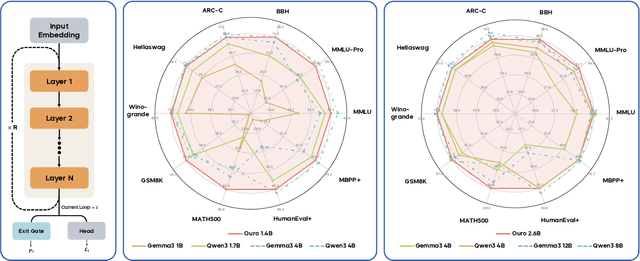
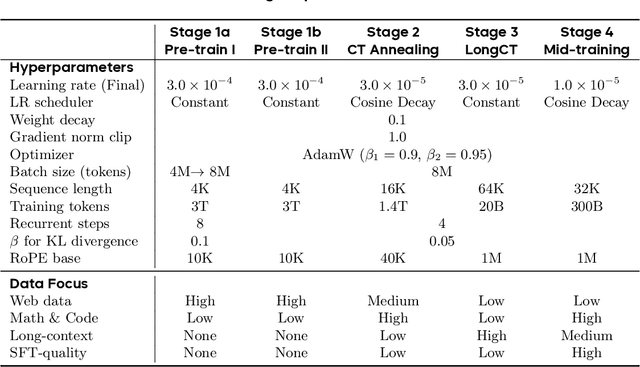
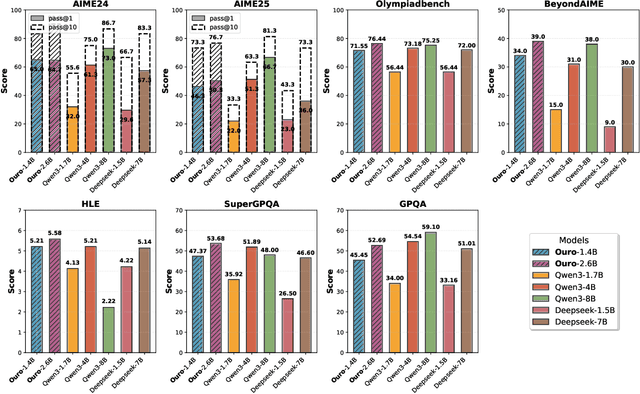

Abstract:Modern LLMs are trained to "think" primarily via explicit text generation, such as chain-of-thought (CoT), which defers reasoning to post-training and under-leverages pre-training data. We present and open-source Ouro, named after the recursive Ouroboros, a family of pre-trained Looped Language Models (LoopLM) that instead build reasoning into the pre-training phase through (i) iterative computation in latent space, (ii) an entropy-regularized objective for learned depth allocation, and (iii) scaling to 7.7T tokens. Ouro 1.4B and 2.6B models enjoy superior performance that match the results of up to 12B SOTA LLMs across a wide range of benchmarks. Through controlled experiments, we show this advantage stems not from increased knowledge capacity, but from superior knowledge manipulation capabilities. We also show that LoopLM yields reasoning traces more aligned with final outputs than explicit CoT. We hope our results show the potential of LoopLM as a novel scaling direction in the reasoning era. Our model could be found in: http://ouro-llm.github.io.
Queries Are Not Alone: Clustering Text Embeddings for Video Search
Oct 09, 2025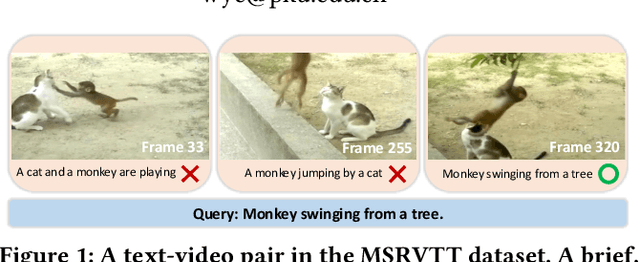

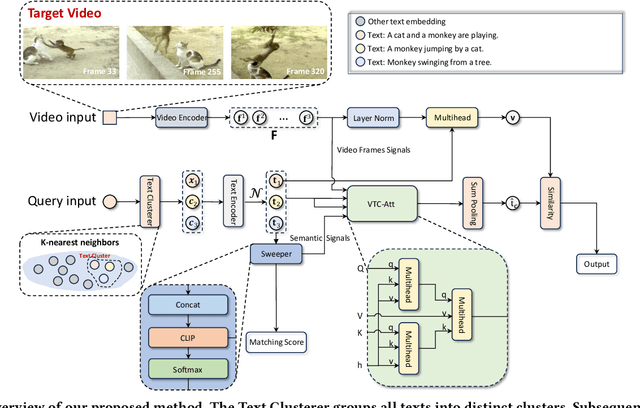

Abstract:The rapid proliferation of video content across various platforms has highlighted the urgent need for advanced video retrieval systems. Traditional methods, which primarily depend on directly matching textual queries with video metadata, often fail to bridge the semantic gap between text descriptions and the multifaceted nature of video content. This paper introduces a novel framework, the Video-Text Cluster (VTC), which enhances video retrieval by clustering text queries to capture a broader semantic scope. We propose a unique clustering mechanism that groups related queries, enabling our system to consider multiple interpretations and nuances of each query. This clustering is further refined by our innovative Sweeper module, which identifies and mitigates noise within these clusters. Additionally, we introduce the Video-Text Cluster-Attention (VTC-Att) mechanism, which dynamically adjusts focus within the clusters based on the video content, ensuring that the retrieval process emphasizes the most relevant textual features. Further experiments have demonstrated that our proposed model surpasses existing state-of-the-art models on five public datasets.
Who Stole Your Data? A Method for Detecting Unauthorized RAG Theft
Oct 09, 2025Abstract:Retrieval-augmented generation (RAG) enhances Large Language Models (LLMs) by mitigating hallucinations and outdated information issues, yet simultaneously facilitates unauthorized data appropriation at scale. This paper addresses this challenge through two key contributions. First, we introduce RPD, a novel dataset specifically designed for RAG plagiarism detection that encompasses diverse professional domains and writing styles, overcoming limitations in existing resources. Second, we develop a dual-layered watermarking system that embeds protection at both semantic and lexical levels, complemented by an interrogator-detective framework that employs statistical hypothesis testing on accumulated evidence. Extensive experimentation demonstrates our approach's effectiveness across varying query volumes, defense prompts, and retrieval parameters, while maintaining resilience against adversarial evasion techniques. This work establishes a foundational framework for intellectual property protection in retrieval-augmented AI systems.
Autoformalizer with Tool Feedback
Oct 08, 2025



Abstract:Autoformalization addresses the scarcity of data for Automated Theorem Proving (ATP) by translating mathematical problems from natural language into formal statements. Efforts in recent work shift from directly prompting large language models to training an end-to-end formalizer model from scratch, achieving remarkable advancements. However, existing formalizer still struggles to consistently generate valid statements that meet syntactic validity and semantic consistency. To address this issue, we propose the Autoformalizer with Tool Feedback (ATF), a novel approach that incorporates syntactic and consistency information as tools into the formalization process. By integrating Lean 4 compilers for syntax corrections and employing a multi-LLMs-as-judge approach for consistency validation, the model is able to adaptively refine generated statements according to the tool feedback, enhancing both syntactic validity and semantic consistency. The training of ATF involves a cold-start phase on synthetic tool-calling data, an expert iteration phase to improve formalization capabilities, and Direct Preference Optimization to alleviate ineffective revisions. Experimental results show that ATF markedly outperforms a range of baseline formalizer models, with its superior performance further validated by human evaluations. Subsequent analysis reveals that ATF demonstrates excellent inference scaling properties. Moreover, we open-source Numina-ATF, a dataset containing 750K synthetic formal statements to facilitate advancements in autoformalization and ATP research.
SAEMark: Multi-bit LLM Watermarking with Inference-Time Scaling
Aug 11, 2025



Abstract:Watermarking LLM-generated text is critical for content attribution and misinformation prevention. However, existing methods compromise text quality, require white-box model access and logit manipulation. These limitations exclude API-based models and multilingual scenarios. We propose SAEMark, a general framework for post-hoc multi-bit watermarking that embeds personalized messages solely via inference-time, feature-based rejection sampling without altering model logits or requiring training. Our approach operates on deterministic features extracted from generated text, selecting outputs whose feature statistics align with key-derived targets. This framework naturally generalizes across languages and domains while preserving text quality through sampling LLM outputs instead of modifying. We provide theoretical guarantees relating watermark success probability and compute budget that hold for any suitable feature extractor. Empirically, we demonstrate the framework's effectiveness using Sparse Autoencoders (SAEs), achieving superior detection accuracy and text quality. Experiments across 4 datasets show SAEMark's consistent performance, with 99.7% F1 on English and strong multi-bit detection accuracy. SAEMark establishes a new paradigm for scalable watermarking that works out-of-the-box with closed-source LLMs while enabling content attribution.
Bootstrap Deep Spectral Clustering with Optimal Transport
Aug 06, 2025Abstract:Spectral clustering is a leading clustering method. Two of its major shortcomings are the disjoint optimization process and the limited representation capacity. To address these issues, we propose a deep spectral clustering model (named BootSC), which jointly learns all stages of spectral clustering -- affinity matrix construction, spectral embedding, and $k$-means clustering -- using a single network in an end-to-end manner. BootSC leverages effective and efficient optimal-transport-derived supervision to bootstrap the affinity matrix and the cluster assignment matrix. Moreover, a semantically-consistent orthogonal re-parameterization technique is introduced to orthogonalize spectral embeddings, significantly enhancing the discrimination capability. Experimental results indicate that BootSC achieves state-of-the-art clustering performance. For example, it accomplishes a notable 16\% NMI improvement over the runner-up method on the challenging ImageNet-Dogs dataset. Our code is available at https://github.com/spdj2271/BootSC.
HSSBench: Benchmarking Humanities and Social Sciences Ability for Multimodal Large Language Models
Jun 04, 2025



Abstract:Multimodal Large Language Models (MLLMs) have demonstrated significant potential to advance a broad range of domains. However, current benchmarks for evaluating MLLMs primarily emphasize general knowledge and vertical step-by-step reasoning typical of STEM disciplines, while overlooking the distinct needs and potential of the Humanities and Social Sciences (HSS). Tasks in the HSS domain require more horizontal, interdisciplinary thinking and a deep integration of knowledge across related fields, which presents unique challenges for MLLMs, particularly in linking abstract concepts with corresponding visual representations. Addressing this gap, we present HSSBench, a dedicated benchmark designed to assess the capabilities of MLLMs on HSS tasks in multiple languages, including the six official languages of the United Nations. We also introduce a novel data generation pipeline tailored for HSS scenarios, in which multiple domain experts and automated agents collaborate to generate and iteratively refine each sample. HSSBench contains over 13,000 meticulously designed samples, covering six key categories. We benchmark more than 20 mainstream MLLMs on HSSBench and demonstrate that it poses significant challenges even for state-of-the-art models. We hope that this benchmark will inspire further research into enhancing the cross-disciplinary reasoning abilities of MLLMs, especially their capacity to internalize and connect knowledge across fields.
Jigsaw-Puzzles: From Seeing to Understanding to Reasoning in Vision-Language Models
May 27, 2025Abstract:Spatial reasoning is a core component of human cognition, enabling individuals to perceive, comprehend, and interact with the physical world. It relies on a nuanced understanding of spatial structures and inter-object relationships, serving as the foundation for complex reasoning and decision-making. To investigate whether current vision-language models (VLMs) exhibit similar capability, we introduce Jigsaw-Puzzles, a novel benchmark consisting of 1,100 carefully curated real-world images with high spatial complexity. Based on this dataset, we design five tasks to rigorously evaluate VLMs' spatial perception, structural understanding, and reasoning capabilities, while deliberately minimizing reliance on domain-specific knowledge to better isolate and assess the general spatial reasoning capability. We conduct a comprehensive evaluation across 24 state-of-the-art VLMs. The results show that even the strongest model, Gemini-2.5-Pro, achieves only 77.14% overall accuracy and performs particularly poorly on the Order Generation task, with only 30.00% accuracy, far below the performance exceeding 90% achieved by human participants. This persistent gap underscores the need for continued progress, positioning Jigsaw-Puzzles as a challenging and diagnostic benchmark for advancing spatial reasoning research in VLMs.
 Add to Chrome
Add to Chrome Add to Firefox
Add to Firefox Add to Edge
Add to Edge